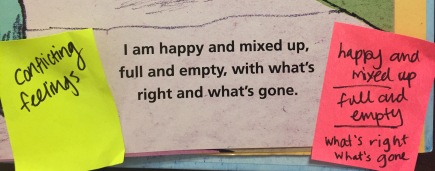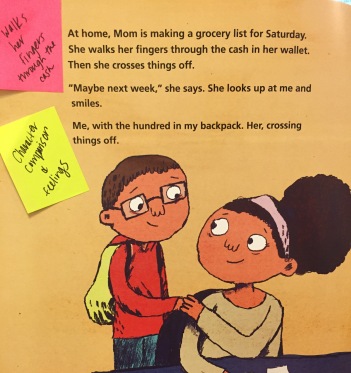I don’t know a teacher who doesn’t love Maribeth Boelts’s classroom classic, Those Shoes (Candlewick, 2007). I’ve never had a group of students that didn’t cringe in deepest sympathy and embarrassment when Jeremy has to wear the “Mr. Alfrey shoes.” I’ve never seen a group of teachers and students who can’t talk on and on about why Jeremey really gives those cool shoes to Antonio. It’s the best kind of book–one teachers and students are equally excited to be reading.
Boelts hits the same notes of pleasing teachers and students with A Bike Like Sergio’s (Candlewick, 2016). Students and teachers alike will connect with Ruben, who is desperate for a bike like the one his friend Sergio has. One day Ruben picks up a what he thinks is a dollar dropped by a lady in a store. It turns out to be a one hundred dollar bill. He’s rich! With various twists and turns, Ruben loses the money, finds it again, and ultimately figures out the right thing to do.
This relatable book is sure to hook kids (there were audible gasps in second grade when Ruben realized the dollar was really a hundred dollars). It’s also a versatile title for teaching reading comprehension skills. Just as I did with my spotlight on The Quickest Kid in Clarksville, I will break down possible uses for this text across Jennifer Serravallo’s categories:
- Plot and Setting
- Character

- Vocabulary and Figurative Language
- Themes and Ideas
I stickied up the text at moments that seemed to lend themselves to teaching in a particular area and compiled my list. New for this post, I also put together a menu of Text-Dependent Questions to use with this book.
Plot and Setting
- There is more than one problem in this story and students will have to sift through the smaller problems (not having a bike, losing the money) to to realize the big issue is Ruben’s internal struggle over the money he finds.
- Students will have to follow some small shifts in time, but all places would be familiar enough to most students to not present a challenge.
Character
- Character background is revealed through dialogue. A conversation between Ruben and Sergio implies that Sergio’s family has money but Ruben’s does not. Understanding this is crucial to understanding the story.

- Across the text, students will need to infer Ruben’s thoughts and motivation. Once he has the dollar he doesn’t tell his parents. He pretends to be asleep when Dad gets home. Why?
- The lady who drops the money and Ruben’s parents don’t play enormous roles in the story, but as secondary characters they do influence Ruben’s feelings and ultimately his actions.
- Ruben feels complex and conflicting emotions upon taking the money and upon giving it back. If you are working on going beyond “happy” and “sad”, this book presents a perfect gateway to “guilt”and “uneasiness.”

Vocabulary and Figurative Language
- I just love this page. “She walks her fingers through the cash in her wallet. Then she crosses things off.”

- Similes:
- “I squeeze my eyes shut and stay still as stone.”
- “And like a hot blast, I remember how it was for me when that money was hers -then mine-was gone.”
- “…the words bust loose like they’ve been waiting.”
- When Ruben loses the money: “Leaves and money look the same. Rain and tears feel the same.”
Themes and Ideas
- This is a great book for taking students from surface level lessons to more meaningful lessons. Some students may initially say the lesson of this text is that you shouldn’t steal, but when they dig in, they’ll realize this book is really about doing the right thing, even when it’s hard.
- As is often the case, an older, wiser character states the lesson explicitly, as a “pearl of wisdom” if you will.

Do yourself a favor and read this one. Read it just to enjoy it, then read it to grow stronger readers.
